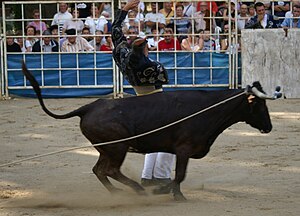
The course landaise is an ancient form of bullfighting and bull-leaping held in oval or rectangular arenas covered in sand, that involves no bloodshed. Experienced cows, with large horns, aged generally from 2 to 14 years old, are used instead of bulls. They are athletic but (by modern standards) small animals selected from the same breed as the bulls used for the Spanish corridas. In Gascony, it is a major spectator sport, counting as many as 600 events each year.[1][2]
The course landaise is one of various forms of entertainment involving a bull or a cow found throughout the south of France, and the Iberian peninsula. The course landaise is for the most part the main attraction of the yearly celebrations held in villages of western Gascony (Bas-Armagnac, Chalosse, and Bearn) and as far west as Bayonne. Other forms of related entertainments are the running of the bulls made famous in the neighboring Spanish Basque Country by the Ferias of Pamplona, but also enjoyed in Bayonne and smaller towns of Gascony such as Nogaro. The course landaise can in a way be compared with the steer-wrestling events in American rodeos to the extent that they are related expressions of a rural culture that can be traced to the ancient Basque tradition of Iberia.[3][unreliable source] of running in front of bulls.
This form of bullfighting is a traditional game of cow or bull dodging and leaping. One needs courage, composure and agility to participate in this dangerous sport. Deaths of toreros or écarteurs, although rare, do happen occasionally. The écarteurs are well-respected professionals but never earn enough to support themselves with the sport alone. However, their passion for this dangerous sport allows them to benefit from the full support of the aficionados throughout the region.[citation needed]
- ^ "Federation Française de la Course Landaise". Archived from the original on 2008-11-23. Retrieved 2008-12-03.
- ^ This article is largely based on the Course landaise article in the French Wikipedia.
- ^ The French novel L'Écarteur (The dodger) from Emmanuel Delbousquet published in 1904.